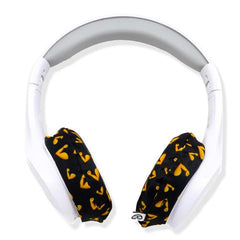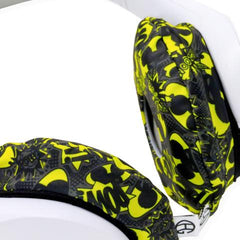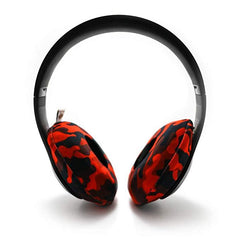Velour Vs Leather Ear Pads
You’d think buying headphones was easy. It can be. Some people have an innate idea of what they want or need and can pick out the perfect pair easily. Others may be so loyal to a specific brand or product that they wouldn’t dream of looking anywhere else.
For many of us, however, buying headphones means making a series of choices: open-back or closed back? Wired or wireless? Active noise-cancelling or passive? White or black? Bose or Beats? Budget or higher-end.
It can be exhausting.
Now, we don’t want to pile more features onto your long shopping list, but you might also want to think about the material covering your earpads, because it’s not just about comfort. It’s also about how you’ll perceive the audio when you’re wearing them.
Most headphones earpads are made either with plastic leather, leather, or velour. Plastic leather (or pleather) is most common as it’s relative durable and cheaper to make.
What is Velour?
Velour is a knit fabric made from cotton and used to imitate velvet (which is more expensive). Velour is soft and almost fuzzy to the touch. It’s worn for comfort but is wildly known as being a difficult fabric to clean.
What is Leather?
Most people are familiar with leather. Made from the rawhide and skin of cattle, it’s widely used in the manufacturing of clothes, accessories and household furnishings. More common than leather however, is synthetic leather also known as vegan or protein leather. It’s made from plastic and whilst it may look like the real thing, it isn’t as hardwearing. You should bear this in mind when shopping for new headphones.
Leather Vs Velour Earpads: Which is Better?
Velour Pros and Cons
Although comfort will always boil down to personal choice, velour headphones are generally considered to be more comfortable. The material is softer against the face and ears than leather and pleather.
Velour is also more breathable than leather. Your ears won’t sweat as much when you’re wearing them.
Air allowed to flow through the fabric has a second benefit: it creates a wider soundstage in the same way that open-back headphones do. This helps create a more natural sound and is one reason why velour earpads are popular with gamers.
Velour is more expensive. It’s also not as durable as real leather and will need replacing sooner.
Velour earpads are harder to clean, too. It means that stains and marks cannot easily be wiped off.
Velour also provides less of a seal between the headphone and the ear. This is what helps create that more natural sound but not everyone will like that. Velour will let more ambient noise through which will be distracting for those who prefer noise isolation. This also means that the bass will be toned down. If bass is important to you, consider leather or another alternative.
Leather/ Pleather Pros and Cons
Most headphone earpads are made from plastic leather. It’s worth checking yours before you adopt any cleaning routine with them. Putting leather conditioner onto pleather, for example, won’t do any good.
Leather isolates sounds better as it seals to the ear more effectively. Generally, people use it more for closed-back headphones so it’s a better choice for people in busier environments like open-plan offices or on flights where they’re competing with engine noise.
Leather and plastic is easier to clean than velour. Wiping down with a microfiber cloth will help remove sweat and grease. Add moisture-resistant covers to protect them from sweat and to help prevent unpleasant smells developing or your cushions from flaking and peeling.
It’s a more classic look, too. Many people prefer leather because it adds an air of sophistication to the headphones.
Leather is less breathable, however. You may find your ears getting hot.
Real leather tends to soak up grease and sweat more easily than velour.
Real leather can be expensive. Synthetic leather won’t last as long.
The material on the earpads isn’t the be-all and end-all of choosing headphones. Some people will be limited by budget or brand and unable to try velour over pleather. Others will choose leather for open-backed headphones because velour makes their ears itch. It’s a free world. You choose which is best for you.
Buying headphones that allow you to replace the earpads will help. You can try both and see what works. If you have the chance to try a pair on before you buy, that can be helpful. Thinking about the most important functions your headphones must fulfil (noise cancelling, gaming, exercise, etc), can help speed the decision-making process up, too.
Don’t forget to pick up a pair of headphone covers on the GymHugz store to protect your earpads from moisture and stains.





